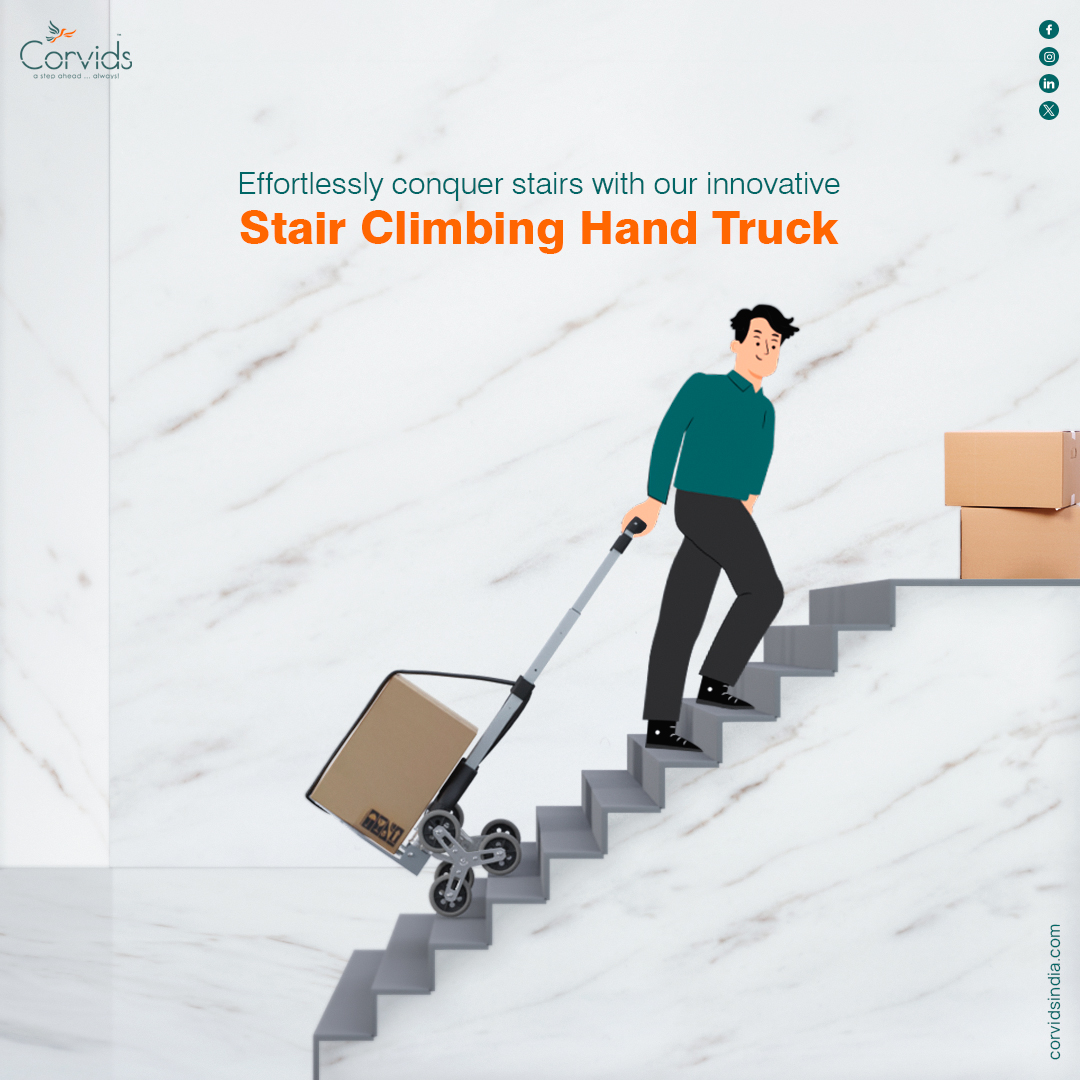All You Need to Know About Stair Climbing Hand Trucks
In a world where efficiency and convenience are paramount, the stair-climbing hand truck stands as a revolutionary solution for transporting heavy loads across different terrains. Also known as a stair climbing dolly, this innovative tool is enough to make your life easy and effortless, especially for tasks involving maneuvering bulky items up or down stairs or uneven surfaces.
What is a Stair Climbing Hand Truck
The stair-climbing hand truck is a versatile and durable piece of equipment designed to simplify the daunting task of moving heavy loads. It combines the functionalities of a traditional hand truck with added features that enable it to traverse stairs effortlessly. Its sturdy frame, coupled with specialized wheels, allows for smooth ascents and descents, reducing strain on the user and ensuring the safety of the cargo.
Features and Benefits
Enhanced Mobility
The primary advantage of a stair climbing hand truck is its ability to navigate stairs seamlessly. Equipped with tri-wheels or tracks, these trucks distribute the weight of the load evenly, making it easier to pull or push up and down stairs without excessive effort.
Versatility in Terrain
Apart from stairs, these hand trucks are designed to handle various terrains. Whether it’s uneven surfaces, curbs, or rough ground, the robust construction and specialized wheels ensure stability and ease of movement.
Heavy-Duty Performance
Built to withstand heavy loads, these hand trucks come in various weight capacities, catering to a wide range of moving needs. From household furniture to commercial supplies, they can handle substantial weight while maintaining stability.
Industrial Applications
In warehouse and industrial settings, stair-climbing hand trucks prove invaluable. They streamline operations by efficiently moving stock, equipment, and heavy items, thereby optimizing productivity and reducing physical strain on workers.
Choosing the Right Stair Climbing Hand Truck
When selecting the right hand truck for your specific needs, several crucial factors should be taken into consideration to ensure optimal performance and efficiency:
Weight Capacity:
Determining the weight capacity you require is essential. Assess the heaviest load you anticipate moving regularly and select a hand truck with a weight capacity significantly higher than that to accommodate variations in weight. Overloading a hand truck can compromise its functionality and pose safety risks.
Wheel Design and Type:
Wheel Size: Larger wheels provide better maneuverability over rough terrain, while smaller wheels are suitable for smooth surfaces.
Wheel Material: Consider wheel materials such as rubber, pneumatic (air-filled), or solid. Each has its advantages – rubber for shock absorption, pneumatic for handling uneven surfaces, and solid for durability and maintenance-free operation.
Frame Material and Construction:
Quality construction materials are vital for durability and longevity. Common materials include steel, aluminum, and reinforced plastics. Consider the environmental conditions the hand truck will encounter to choose the most suitable material.
Handle Design and Ergonomics:
An ergonomic handle design is crucial for user comfort and reducing strain during operation. Look for handles with comfortable grips and adjustable heights, allowing users of varying statues to work comfortably.
Folding and Storage Capability:
For space-saving storage and transportation, opt for hand trucks with folding capabilities. Foldable models are convenient for smaller spaces and transportation in vehicles.
Additional Features:
Braking Mechanism: Some hand trucks come equipped with brakes, which can be beneficial when navigating steep inclines or when stationary on an uneven surface.
Convertible Models: Certain hand trucks offer convertible features, allowing them to function as both a traditional upright hand truck and a platform cart, providing added versatility.
Customization Options:
Look for hand trucks that offer customization options or accessories such as extended frames, specialized attachments, or additional support straps. These can enhance the hand truck’s functionality based on your specific needs.
Industry-Specific Requirements:
Different industries may have unique requirements for hand trucks:
- Warehouse and Industrial Use: Consider heavy-duty hand trucks capable of handling large and heavy items commonly found in warehouse environments.
- Delivery Services: Lightweight, maneuverable hand trucks with good handling on stairs might be preferred for navigating urban settings and apartment buildings.
- Retail and Commercial Use: Hand trucks suitable for navigating aisles and carrying merchandise efficiently can streamline retail operations.
Cost vs. Quality:
While considering budget constraints is important, investing in a higher-quality hand truck often pays off in the long run. Quality hand trucks are more durable, require less maintenance, and offer better performance, potentially saving money on replacements and repairs.
Testing and Reviews:
Before making a purchase, read user reviews and, if possible, test the hand truck. Understanding other users’ experiences and physically trying the equipment can provide valuable insights into its functionality and suitability for your specific needs.
Applications in Various Industries
Stair climbing hand trucks find applications in multiple industries:
- Moving and Logistics: Ideal for moving companies, these trucks simplify the transportation of furniture and heavy items during relocations.
- Retail and Warehousing: In retail settings, these hand trucks aid in stocking shelves and transporting inventory, while warehouses benefit from their efficiency in moving goods.
- Delivery Services: Courier and delivery companies utilize stair-climbing hand trucks to manage parcels and packages efficiently, especially in buildings without elevators.
Maintenance and Care Tips:
ensuring proper maintenance and care for your hand truck is essential to prolong its lifespan and maintain its efficiency. Here are additional points to consider:
Lubrication:
Regularly lubricate moving parts such as hinges, axles, and joints to prevent rust and ensure smooth operation. Use appropriate lubricants as recommended by the manufacturer to maintain optimal functionality.
Inspection of Components:
- Wheels and Tires: Check the condition of the wheels and tires regularly. Replace any worn-out or damaged wheels to maintain stability and ease of movement.
- Handles and Grips: Inspect handles and grips for wear or damage. Damaged handles can cause discomfort or compromise control while operating the hand truck.
Cleaning and Hygiene:
- Debris Removal: Clean the hand truck regularly to remove debris, dirt, or any other residues that might accumulate. A buildup of debris can affect the functionality of moving parts.
- Sanitization: Especially in settings where hygiene is crucial (e.g., medical facilities or food services), regularly sanitize the hand truck to prevent the spread of germs or contaminants.
Storage Practices:
- Proper Positioning: Store the hand truck in a dry, sheltered area to protect it from environmental factors like rain or direct sunlight that may cause deterioration.
- Securing Position: When storing vertically, ensure the hand truck is secured against a wall or stored within a rack to prevent accidental falls or damage.
Load Handling Techniques:
- Proper Loading: Ensure loads are placed evenly and securely on the hand truck to maintain balance and stability during transportation.
- Weight Distribution: Distribute weight evenly to prevent overloading the hand truck, which can lead to strain on the equipment and potential accidents.
Training and User Knowledge:
- Training Programs: If multiple users handle the hand truck, provide adequate training on its proper usage and maintenance to ensure uniform handling practices.
- User Manuals: Encourage users to refer to the manufacturer’s manual for maintenance guidelines and best practices.
Periodic Professional Check-ups:
Arrange for periodic inspections by professionals or technicians to assess the hand truck’s condition thoroughly. Professional checks can identify potential issues early and prevent major breakdowns.
Record Keeping:
Maintain a maintenance log or schedule to track cleaning, lubrication, and inspection dates. This record-keeping ensures timely maintenance and aids in identifying patterns or recurring issues.
These tips significantly extend the lifespan of your stair climbing hand truck, optimize its performance, and ensure safe and efficient handling of loads across various circumstances.
Take Away
The stair climbing hand truck is a versatile, durable, and indispensable tool for moving heavy loads efficiently across various terrains, including stairs and rough surfaces. Its unique design and features make it a valuable asset in industries like logistics, retail, and delivery services, significantly simplifying the handling of bulky items and streamlining operations. Regular maintenance ensures its longevity, making it a worthy investment for both residential and commercial purposes.



